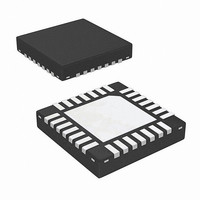ISL62884CHRTZ Intersil, ISL62884CHRTZ Datasheet - Page 16

ISL62884CHRTZ
Manufacturer Part Number
ISL62884CHRTZ
Description
IC REG PWM SGL PHASE 28WQFN
Manufacturer
Intersil
Datasheet
1.ISL62884CHRTZ.pdf
(30 pages)
Specifications of ISL62884CHRTZ
Applications
Controller, Intel IMVP-6
Voltage - Input
4.5 ~ 25 V
Number Of Outputs
1
Voltage - Output
0.0125 ~ 1.5 V
Operating Temperature
-10°C ~ 100°C
Mounting Type
Surface Mount
Package / Case
28-WQFN
Rohs Compliant
Yes
Lead Free Status / RoHS Status
Lead free / RoHS Compliant
The default OCP threshold is the value when R
not populated. It is recommended to scale the droop
current I
gives approximately the desired OCP level, then use
R
For overcurrent condition above 2.5x the OCP level, the
PWM output will immediately shut off and PGOOD will go
low to maximize protection. This protection is also
referred to as way-overcurrent protection or
fast-overcurrent protection, for short-circuit protections.
The ISL62884C will declare undervoltage (UV) fault and
latch off if the output voltage is less than the VID set
value by 300mV or more for 1ms. Thus, will turn off the
PWM output and de-assert PGOOD.
The ISL62884C has two levels of overvoltage
protections. The first level of overvoltage protection is
referred to as PGOOD overvoltage protection. If the
output voltage exceeds the VID set value by +200mV for
1ms, the ISL62884C will declare a fault and de-assert
PGOOD.
The ISL62884C takes the same actions for all of the
above fault protections: de-assertion of PGOOD and
turn-off of the high-side and low-side power MOSFETs.
Any residual inductor current will decay through the
MOSFET body diodes. These fault conditions can be reset
by bringing VR_ON low or by bringing V
POR threshold. When VR_ON and V
high operating levels, a soft-start will occur.
The second level of overvoltage protection is different. If
the output voltage exceeds 1.7V, the ISL62884C will
immediately declare an OV fault, de-assert PGOOD, and
turn on the low-side power MOSFETs. The low-side power
MOSFETs remain on until the output voltage is pulled
down below 0.85V when all power MOSFETs are turned
off. If the output voltage rises above 1.7V again, the
protection process is repeated. This behavior provides
the maximum amount of protection against shorted
high-side power MOSFETs while preventing output
ringing below ground. Resetting VR_ON cannot clear the
1.7V OVP. Only resetting V
is active all the time when the controller is enabled, even
(kΩ)
MIN
TABLE 3. ISL62884C OCP THRESHOLD AND
305
205
155
104
comp
78
62
45
to fine tune the OCP level if necessary.
NOMINAL
DROOP
R
(kΩ)
none
comp
400
235
165
120
OVERSHOOT REDUCTION FUNCTION
85
66
50
such that the default OCP threshold
MAX
(kΩ)
none
410
240
170
130
90
68
55
16
DD
THRESHOLD
will clear it. The 1.7V OVP
(µA)
OCP
60
68
62
54
60
68
62
54
DD
return to their
DD
OVERSHOOT
REDUCTION
below the
FUNCTION
Disabled
Enabled
comp
ISL62884C
is
Overcurrent
Way-Overcurrent
(2.5xOC)
Overvoltage +200mV
Undervoltage -300mV
Overvoltage 1.7V
if one of the other faults have been declared. This
ensures that the processor is protected against high-side
power MOSFET leakage while the MOSFETs are
commanded off.
Table 4 summarizes the fault protections.
Adaptive Body Diode Conduction Time
Reduction
In DCM, the controller turns off the low-side MOSFET
when the inductor current approaches zero. During
on-time of the low-side MOSFET, phase voltage is negative
and the amount is the MOSFET r
which is proportional to the inductor current. A phase
comparator inside the controller monitors the phase
voltage during on-time of the low-side MOSFET and
compares it with a threshold to determine the
zero-crossing point of the inductor current. If the inductor
current has not reached zero when the low-side MOSFET
turns off, it’ll flow through the low-side MOSFET body
diode, causing the phase node to have a larger voltage
drop until it decays to zero. If the inductor current has
crossed zero and reversed the direction when the low-side
MOSFET turns off, it’ll flow through the high-side MOSFET
body diode, causing the phase node to have a spike until it
decays to zero. The controller continues monitoring the
phase voltage after turning off the low-side MOSFET and
adjusts the phase comparator threshold voltage
accordingly in iterative steps such that the low-side
MOSFET body diode conducts for approximately 40ns to
minimize the body diode-related loss.
Overshoot Reduction Function
The ISL62884C has an optional overshoot reduction
function, enabled or disabled by the resistor from the
COMP pin to GND, as shown in Table 3.
When a load release occurs, the energy stored in the
inductors will dump to the output capacitor, causing
output voltage overshoot. The inductor current
freewheels through the low-side MOSFET during this
period of time. The overshoot reduction function turns off
the low-side MOSFET during the output voltage
FAULT TYPE
TABLE 4. FAULT PROTECTION SUMMARY
120µs
<2µs
1ms
Immediately
PROTECTION
DURATION
BEFORE
FAULT
DS(ON)
PWM tri-state,
PGOOD latched
low
Low-side
MOSFET on
until V
<0.85V, then
PWM tri-state,
PGOOD latched
low.
PROTECTION
ACTION
voltage drop,
core
March 16, 2010
VR_ON
toggle
or VDD
toggle
VDD
toggle
FAULT
RESET
FN7591.0











